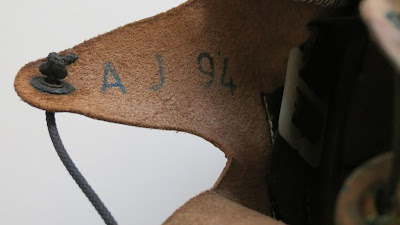(For part one go here)
What's not to like about Austria?
And what's not to like about the Austrian M75 helmet? It's a clone of the US M1 that goes the original one better...or maybe two better.
The walk-around provides no surprises to anyone familiar with the M1.


The helmet rim is butt-joined and spot welded at the rear.

Really nice and crisp date and manufactures mark are on the inside rear of the shell; Ulbrichts Witwe in Kaufing 34, 4690 Schwanenstadt (U SCH). That Austrian eagle is very cool.

The helmet with the "erbsentarn" side of the fabric camouflage cover, secured by a band made of a rubber inner-tube.

The camouflage cover is two-sided with distinctly different patterns: "erbsentarn" on the left and "sumpftarn" on the right.
Camouflage helmet covers were not a standard-issue item in the Bundesheer in the days of the M75.
Instead patterns were sent to individual units to convert pieces of shelter halves into covers. Mats excellent helmet cover site at: http://www.matshelmets.se/at_cov.html provides more details on this and other camouflage covers.
Instead patterns were sent to individual units to convert pieces of shelter halves into covers. Mats excellent helmet cover site at: http://www.matshelmets.se/at_cov.html provides more details on this and other camouflage covers.
This salvage of material can be seen in the miscellaneous seams and folds in the cover...
as well as the jagged and non-sewn edges of the fingers.
The sumpftarn side.
Though a near-clone of the venerable US M1 helmet, this helmet has two distinct
and simple improvements.
The chinstrap release is elegant and far superior to the three versions of chinstrap closures that the US utilized over the course of fifty years, none of which was nearly as effective as the Austrian version. It's a simple open garter fastner which fits around the circular washer (at top). the garter spring holds the washer securely and releases with a simple tug.
The second improvement is equally elegant. A simple spring clip on each side that securely holds the liner in place. The liner and the shell of the US M1 often have a fit so loose that the shell will fall away from the liner when inverted. These Austrian spring clips hold the liner while making it simple to separate the two components. (This just in: see Greg's comment below)
Okay, so not everyone's perfect.
The liner is nothing like the US M1 but shares a similarity with the Bundeswehr of Germany (I just caught myself typing "West Germany"; am I old school, or what?).
The plastic liner has a much more trim profile than the US M1.
But like the M1 liner, it can be worn as a stand-alone piece of headgear.
The suspension is nicely marked, always a treat for the collector.
Size...
and date of manufacture perhaps?
The suspension can be adjusted by strap and buckle as well as by the usual
cord through the fingers.
Like the Bundeswehr, the sweat band is ventilated.
The dome is padded and sports a crosspiece of wide webbing.
Thin foam buffers the suspension from the leather.
The suspension fingers are nicely grommeted. The workmanship of this suspension is first rate.
As with the M1 the liner strap is secured by a garter clip...
and shortened or lengthened by a cam buckle.
I was fortunate to buy this helmet from a fellow collector who provided me with
a very handsome helmet and a great addition to the collection.
See you next time with another cool helmet.




























































